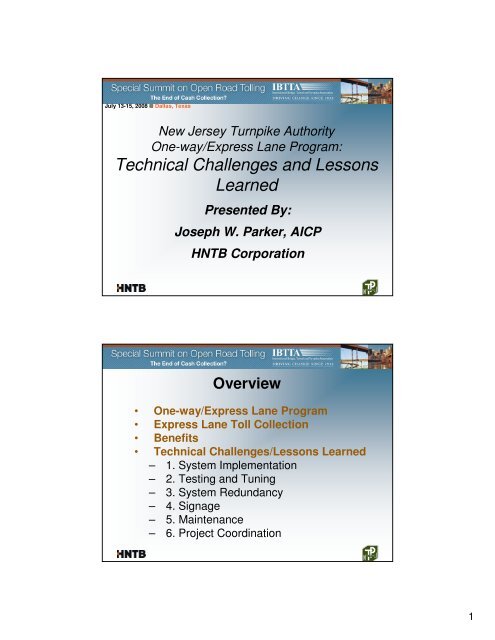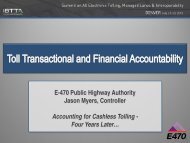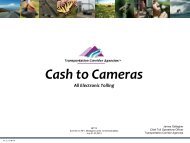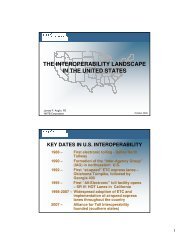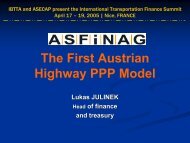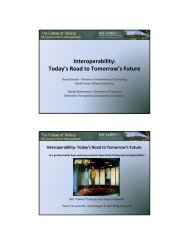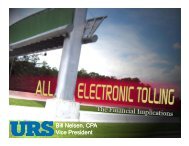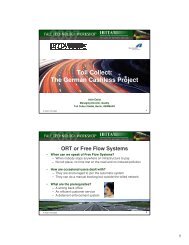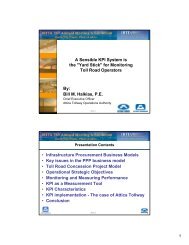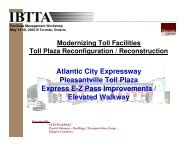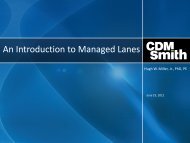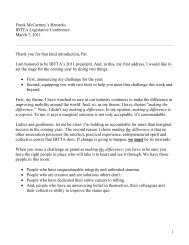New Jersey Turnpike Express E-ZPass Lanes
New Jersey Turnpike Express E-ZPass Lanes
New Jersey Turnpike Express E-ZPass Lanes
Create successful ePaper yourself
Turn your PDF publications into a flip-book with our unique Google optimized e-Paper software.
July 13-15, 2008 Dallas, Texas<br />
<strong>New</strong> <strong>Jersey</strong> <strong>Turnpike</strong> Authority<br />
One-way/<strong>Express</strong> Lane Program:<br />
Technical Challenges and Lessons<br />
Learned<br />
Presented By:<br />
Joseph W. Parker, AICP<br />
HNTB Corporation<br />
Overview<br />
• One-way/<strong>Express</strong> Lane Program<br />
• <strong>Express</strong> Lane Toll Collection<br />
• Benefits<br />
• Technical Challenges/Lessons Learned<br />
– 1. System Implementation<br />
– 2. Testing and Tuning<br />
– 3. System Redundancy<br />
– 4. Signage<br />
– 5. Maintenance<br />
– 6. Project Coordination<br />
1
One-way/<strong>Express</strong> Lane Program<br />
• December 2002 Program Announced -Fast<br />
Track Program<br />
• Reduce the number of stops on longer trips<br />
• Reduce number of transactions<br />
• Collection at highway speeds<br />
• Reduce number of stops/slow downs<br />
• No toll increase<br />
• 8 <strong>Express</strong> Lane Plazas<br />
– 2 Plazas on Closed Ticket System<br />
– 6 Plazas on Barrier System<br />
<strong>Express</strong> lane Toll Collection<br />
• ACS State & Local Solutions (System<br />
Integrator)<br />
• Single Lane, 2-Lane bi-directional, 3-, and 5-<br />
Lane configurations<br />
• Shoulders covered for VES & detection only<br />
• System components<br />
– Mark IV E-<strong>ZPass</strong> antenna array<br />
– IDRIS Loop Vehicle Detection/Classification System<br />
– VES cameras and lighting units<br />
– Overhead laser scanner vehicle separators<br />
2
Benefits<br />
• Fewer toll transactions<br />
• Reduced operational costs<br />
• Improved toll collector safety<br />
• Significant reduction in plaza traffic<br />
congestion<br />
• Improved convenience for customers<br />
Typical Existing Plaza<br />
3
One-way/<strong>Express</strong> Toll <strong>Lanes</strong><br />
Lesson #1 - System Implementation<br />
• Challenges:<br />
– Fast Track Project – ORT Design Unknown<br />
– E-<strong>ZPass</strong> technology limited to 2-Lane ORT<br />
– Bi-directional <strong>Express</strong> <strong>Lanes</strong> increases cross lane<br />
reads<br />
– Stop-and-go traffic deteriorates loop performance<br />
– Front VES light cause driver distraction<br />
• Solutions:<br />
– Space-frame ORT structure allows flexible system<br />
design<br />
– Mark IV developed Cross Lane Read Algorithm for 2+<br />
ORT applications<br />
– Guard Antennas used at bi-directional plazas<br />
– Overhead Scanner used for vehicle separation at low<br />
speed<br />
– Infrared flasher to minimize driver distraction<br />
4
Overhead Space Frame<br />
Pascack Valley Toll Plaza<br />
5
Lesson #2 - Testing and Tuning<br />
• Challenges:<br />
– FAT Site – High-speed test facility<br />
– Each site must be tuned for traffic<br />
– Loop sensitivity problems caused by rebar in concrete and<br />
location of storm grates<br />
– VES system not at peak reliability until system tuning is<br />
complete<br />
• Solutions:<br />
– ACS High-Speed Test Facility- Crofton, Maryland<br />
– Mini FAT performed at installation sites<br />
– Rebar and storm grates repositioned in tolling area to<br />
decrease loop interference<br />
– AVC System tuning process extended<br />
Interchange 18W Toll Plaza<br />
6
Lesson #3 – System Redundancy<br />
• Challenges:<br />
– System failure = Loss of revenue<br />
– All lanes act as single system - System not<br />
designed for single lane closure<br />
– Backup lanes not available<br />
• Solutions:<br />
– Increase level of memory in AVI reader to hold<br />
more tag reads<br />
– Backup lane controllers and other peripherals<br />
required as part of system redundancy<br />
– Degraded mode operations to maintain lane<br />
uptime<br />
Lesson #4 - Signage<br />
• Challenges:<br />
– System identification and patron notification<br />
– Toll system control of Automatic Sign Control<br />
System not implemented<br />
• Solutions:<br />
– Series of static signs erected prior to <strong>Express</strong><br />
<strong>Lanes</strong><br />
– Manual override of Automatic Sign Control System<br />
7
Automatic Sign Control<br />
Lesson #5 - Maintenance<br />
• Challenges:<br />
– ORT failures more critical<br />
– ORT lane closure difficult<br />
– ORT System components located outside<br />
• Solutions:<br />
– More stringent repair and response times<br />
– Most maintenance performed during late night<br />
hours<br />
– Equipment brackets designed for easy removal<br />
and installation<br />
– Modified open shelter to house system<br />
components<br />
8
Raritan S. Plaza – 5 <strong>Express</strong> <strong>Lanes</strong><br />
ETC Shelter<br />
9
Lesson #6 – Project Coordination<br />
• Challenges:<br />
– Agency departments – Engineering, ETC, Tolls,<br />
Maintenance, Operations and Audit<br />
– System Integrator<br />
– Civil/Electrical Designer<br />
– Construction Inspector<br />
– Civil/Electrical Contractors<br />
– System Integrator Equipment Vendors<br />
• Solution:<br />
– Coordination meetings<br />
Conclusion - Lessons Learned<br />
Revisited<br />
1. System Implementation – <strong>New</strong> solutions<br />
2. Testing and Tuning – Increased effort<br />
3. System Redundancy – Absolutely<br />
required<br />
4. Signage – Patron notification<br />
5. Maintenance – Different approach<br />
6. Project Coordination – All parties<br />
involved<br />
10


